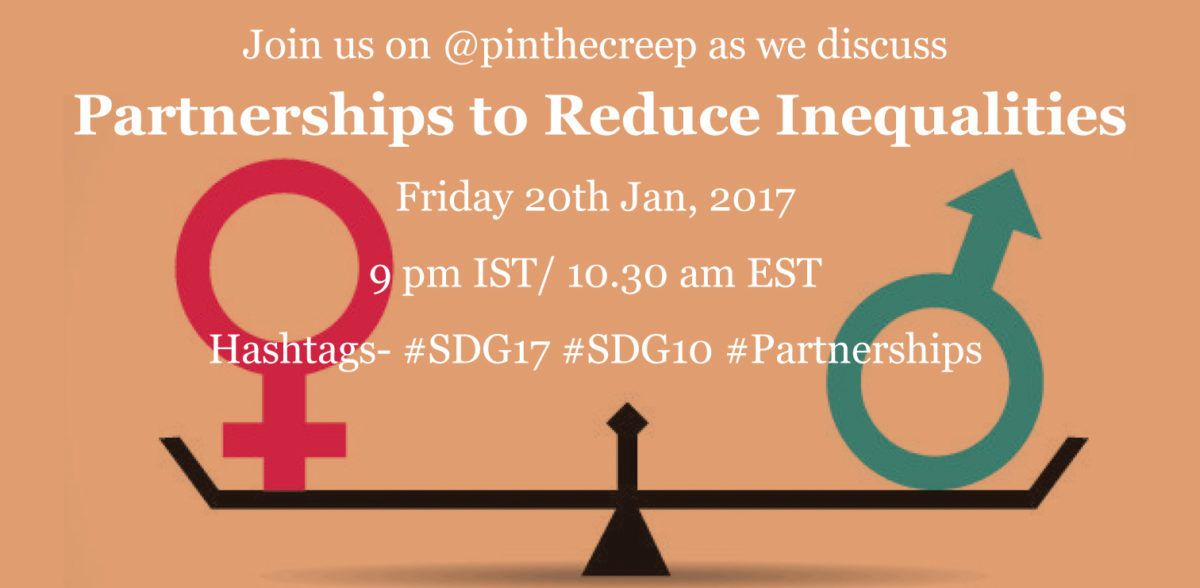SDG 6 : Gender Equality: An overview

Keerthana Gedela is a second year student doing law in DSNLU. She loves all kinds of stuff ranging from music to basketball. She is a foodie and aims to set a mark for herself in this world.
SDG 6 : Gender Equality: An overview
Chat 1 : Partnership to achiever safer spaces.
On Friday 6th Jan, Naina Jha @27nainajha initiated a tweetchat asking everybody in general on how they understood the term “safe space”. Their opinions said that a safe space is a place where women and girls feel secure. Some counter it saying that it is a system rather than a place. Further, the question of how a safe space can lead to overall development of society brought in a clear picture of the topic. Most people spoke of safe spaces as places which nurture the mind of people as a whole helping them express their opinions and speak out. The importance of organisations in helping encourage women to step out to speak of their distress, education, awareness programmes and other activities help in making a safe place for women.
KEY POINTS IN THE CHAT
- Safe space as the word says is a place that negates fear in the minds of women
- Human dignity should also be applied in the case of women in all spheres of their lives
- Exploring the potential of women and helping them grow independent both physically and mentally
- A goal can be properly achieved when someone loses their fear of being threatened
- Organisations help in ensuring not only safety but also equal pay for equal work and gender discrimination at all ranges
- Organisations create an environment viable for learning and enhancing ability to achieve one’s potential
- Adhering to human rights principles in all fields of life will help achieve equality
CHAT 2 : Partnerships to enhance Public Education
On Friday, ApniShala @ApniShala The question on the scope of academics brought out the difference between practical knowledge and theoretical knowledge. The view of practical knowledge has been backed by many people, who support effective communication and personality building where students learn to deal with various challenges in life. This means to move away from the traditional method of teaching and learning. Further, people are positive that private institutions help improvising education through creativity and innovation, workshops and vocational trainings. In the end, it is being concluded that partnerships help facilitate safer education by good infrastructure and safe modes of transport.
KEY POINTS THAT WERE DISCUSSED WERE
- Practical knowledge is a pre-requisite in the contemporary world than a mere theory based system of education
- Non-academic teaching helps effectuate good communication thus breaking the communicative barrier and builds a strong and confident personality among children
- Helps prepare students to face different challenges in life
- Private institutions help in getting “soft skills” through internships, mentorships and career programmes exclusively designed for students.
- Sports, martials arts and Workshops on equality based society and awareness campaigns
- Learning self-defence techniques should be mandatory for girls
CHAT 3 : Partnerships to Reduce Inequalities
On Friday, 30th Jan, Tarannum initiated a chat on inequalities. The chat began with a question asking the types of inequalities still existing in our society. A lot of participants gave their own perception about the kinds they feel still exist ranging from gender equalities, caste, religion, wealth, et cetera. Most people had a similar opinion on these inequalities though framed differently. The chat further moved to whether the world is working on reducing these inequalities. Some spoke about a general inequality we find in educational institutions and the others of the efforts we simply find on paper. Some were optimistic about finding a shift from a stereotypical world while another had honestly never witnessed a change at all. The opinions are variegated depending on their experience. It further proceeds to whether women face any such inequalities and if yes, what are they, and finally, it ended with people expressing their opinions on whether the government or any organisations are doing anything to reduce such inequalities
KEY POINTS DISCUSSED:
- Inequalities vary from caste, sex, race, religion to wealth and many more, and they still exist;
- Gender inequality is the most prevalent form of inequality;
- The world, as per the opinion of a majority, has indeed, worked towards breaking the stereotypical behaviour;
- Women and minorities face discrimination in every field of life;
- Government schemes, legal amendments, education, and international programmes have, to an extent, helped curbing this widespread discrimination.




